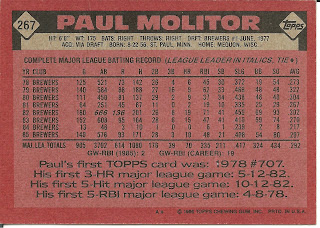Card thoughts: Exciting shot of Molitor throwing out a
runner from third base in spring training. It's not often you see an infielder
lose his hat when making a play, so it is most likely Molitor had to dive for
the ball (or came running in) before making the play. Since Molitor was a below
average fielder (at every position) but an above average hitter (to say the
least) it is interesting that Topps picked a picture of Molitor fielding. But
that's probably because it makes the card exciting.
The player: If you were the pick the most likely young
hitter to make the hall of fame in 1985, I doubt Molitor would be on your list.
But the Hall of Fame is made up both of hitters who were spectacular for, say,
a decade and those who had isolated years of greatness, but many more years of
consistent work. Molitor is of the latter category.
That’s not to say that Molitor was
not considered at least a very good player for most of his career. A first
round pick by the Brewers, he placed second in Rookie of the Year voting in
1978 on the strength of his .273 average, 54 runs scored, and 30 steals. The
next two seasons, Molitor became the Brewers leadoff hitter, hitting over .300
each year and playing all over the field, mostly at second.
Jim Gantner took over at second in
1981, moving Molitor to outfield. He also gave up heavily using cocaine and
marijuana that year. In 1982, Molitor had his first really great year. Arguably
the MVP of the Brewers pennant winners, He led the league with 136 runs, and
contributed to the “Harvey’s
Wallbangers” image of the team by hitting 19 home runs (he would only top this
one more time).
In 1983, Molitor’s numbers were not
quite as spectacular, but he still scored 95 runs and had 41 steals. But the
next year, he injured his elbow in spring training, and eventually had to have
season ending surgery in May. When this card appeared in packs, Molitor had
come all the way back from his injury, and had a year almost identical to the
one he had in 1983, as he made the all-star team for the second time.
The 1987 season was important in
many ways for Molitor. It was the first season that he played the majority of
his games at designated hitter (the Brewers wanted to try Earnie Riles at
third), and although he only played only 118 games, he still led the league
with 114 runs and 41 doubles. But the highlight of the year would have to be
his 39 game hitting streak, the fifth best in history. This helped push his
batting average up to a career high .353. In 1988, Molitor was voted in as the
starting second baseman in the all star game for the first time (this confuses
me: Molitor only played one game at second that year. Why was he listed as a
second baseman on the ballot?). He didn’t get a hit, and struck out one in
three at bats. He almost set a record that season by stealing 20 straight bases
without being caught.
The Paul Molitor pattern was
established: Several years of consistently good production, interrupted by
isolated years of spectacular numbers. One such year was in 1991, when he once
again led the league in runs scored (133) hits for the first time (216) and
triples (13). This was also the point when Molitor became almost exclusively a
designated hitter, which led to a late career renaissance.
When the Brewers wanted to cut his
pay after a down year in 1992, Molitor signed with the Blue Jays. He had one of
his spectacular seasons in first Blue Jay season. With his speed declining,
Molitor was moved from the leadoff spot, and ended up leading the league in
hits (211) and for the first time drove in 100 runs (111). He came in second to
Frank Thomas in MVP voting, and was spectacular in the playoffs, winning the
World Series MVP award by hitting .500 in the series. Look at these stats: 10
runs scored, 12 hits, half of which were for extra bases (2 each of doubles,
triples, and home runs).
One more spectacular Molitor season
was in the works. Now with the Twins, at age 39, Molitor once again led the
league in hits with 225 and hit .341. Even more impressive, he drove in 113
runs while only hitting 9 home runs. Molitor ended his career 1998 while still
a productive hitter (75 runs scored, 69 batted in, .274 average). He
immediately became the Twins bench coach, a position he held for the next three
years.
In all, Molitor amassed 3,319 hits
(9th all time), 1,782 runs scored, 605 doubles (11th all time), and .306
average. He was elected to the Hall of Fame on the first ballot in 2004.
Rear guard: Topps was not very predictive when it came to Molitor, not even deigning him a card ending in a "5" (should have been a zero). Here's Molitor's first Topps card, one of the better multi-rookie cards, as #130 Alan Trammel is also included (Molitor came up as a shortstop). #113 U.L Washington was still playing when the 1986 set was issued. His career is discussed earlier on this blog. The unfortunately named Mickey Klutts is included here on the strength of his 14 homers and 65 RBIs at Syracuse in the International League. He was never more than a reserve shortstop in the majors.
Molitor's 5 hits were against the Cardinals in the first game of the World Series that the Brewers won 10-0. All the hits were singles, and he would go on to hit .355 the rest of the series.


No comments:
Post a Comment